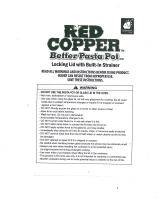
READ THE IMPORTANT SAFEGUARDS AND ALL
INSTRUCTIONS BEFORE USING THE APPLIANCE.
Remove all tape and packaging wrap before using the oven. If any glue remains, touch
the residue with the sticky side of the tape already removed. Or, use a cloth soaked with
rubbing alcohol. Use caution because rubbing alcohol is flammable. Rinse with warm
water and wipe dry.
Destroy the carton and plastic bags after the range is unpacked. Children should not
use packaging material lbr play. Cartons covered with rugs, bedspreads, or plastic sheets
can become air-tight chambers. Remove all staples fi'om the carton. Staples can cause
severe cuts and destroy finishes if they come in contact with other appliances or furniture.
Be safety con_ious. Tire preparation of lood in mroven requires temperalures thai could cause
severn burns. Belbre using this new applimrce, carefully mad arrd lbllow all irrstructions.
[AWARNING]
The California Safe Drinking Water and Toxic Enforcement Act of 1986
(Proposition 65) requires the Governor of Calilornia to publish a list of
substances known to the Stale of Calilornia to cause cancer or reproductive
harm. In addition, businesses nmst warn customers of potential exposure to
such substances.
Users of this appliance are hereby warned there may be some low level exposure to some
of the listed substances including lormaldehyde arrd carbon m(moxide. This happens when
the oven, if equipped with a sell-clean feature, is engaged in a self-clean cycle. Exposure to
these substances can be minimized by properly venting the oven, especially during the self-
cleaning cycle, by opening a window or using a ventilating hood or l_m.
Notice: Never keep pet birds in tire kitchen. Birds have a very sensitive respirmory system.
Fumes released during the self-cleaning cycle, overheated cooking oil, fat, margarine or
overheated non-stick cookware may be harmlhl or fatal to birds.
PROPER INSTALLATION: Be sure your appliance is properly installed and grounded
by a qualified technician in accordance with the National Electrical Code ANSI/NFPA
NO. 70-1at_t edition and local electrical code requirements. Install only per irrstallalion
instructions provided in the literature package for this range. Be sure leveling legs are in phtce
at the bottom corners of the range. If necessary, raise or lower the leveling legs at the base of
the range by turning clockwise or counterclockwise to insure a level range.
Ask your dealer to recommend a qualified technician and an authorized repair service.
Have the technician label the proper switch or lhse at the electrical disconnect box and
show you how to disconnect the power to the range at the circuit breaker or fuse box in
case of an emergency.
[JlLI['wARN[NG[ propertyThefollowingdamage.Situationsmay cause serious bodily harm, death or
• TO REDUCETHERISKOF TIPPINGOFTHE RANGE,THE RANGEMUST BESECURED
BYA PROPERLYINSTALLEDANTI-TIPBRACKETPROVIDEDWITH THE RANGE.TO
CHECK IF THEDEVICE IS INSTALLEDANDENGAGEDPROPERLY,CAREFULLYTIP
THERANGE FORWARD.THEANTI-TIPDEVICESHOULDENGAGEANDPREVENTTHE
RANGE FROM TIPPING OVER. REFER TO THE INSTALLATION INSTRUCTIONS
PACKAGED WITH THE ANTI-TIP BRACKET FOR PROPER ANTI-TIP BRACKET
INSTALLATION.
• Never leave children alone or unattended in the area where an appliance is in use
They should never be allowed to sit or stand on any part of the appliance. Never leave
the oven door open when the range is umtttended.
• Do not store items of interest to children in the cabinets above a range or on the
backguard of a range. Chiktren climbing on the range to reach the items could be
seriously irrjured.




















